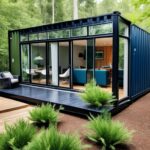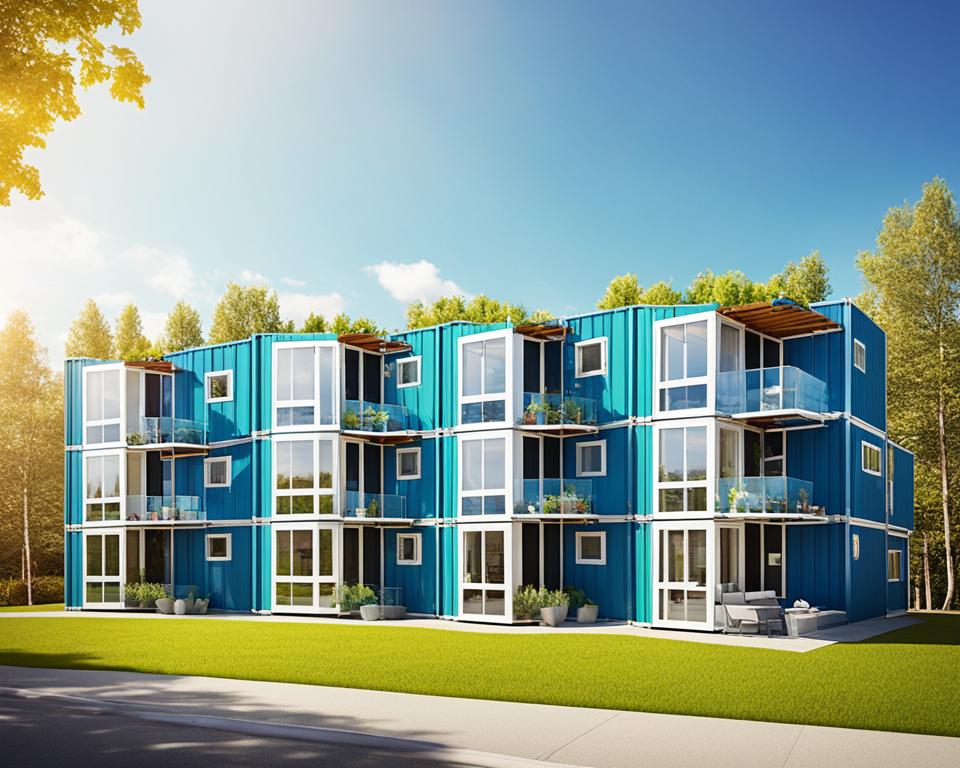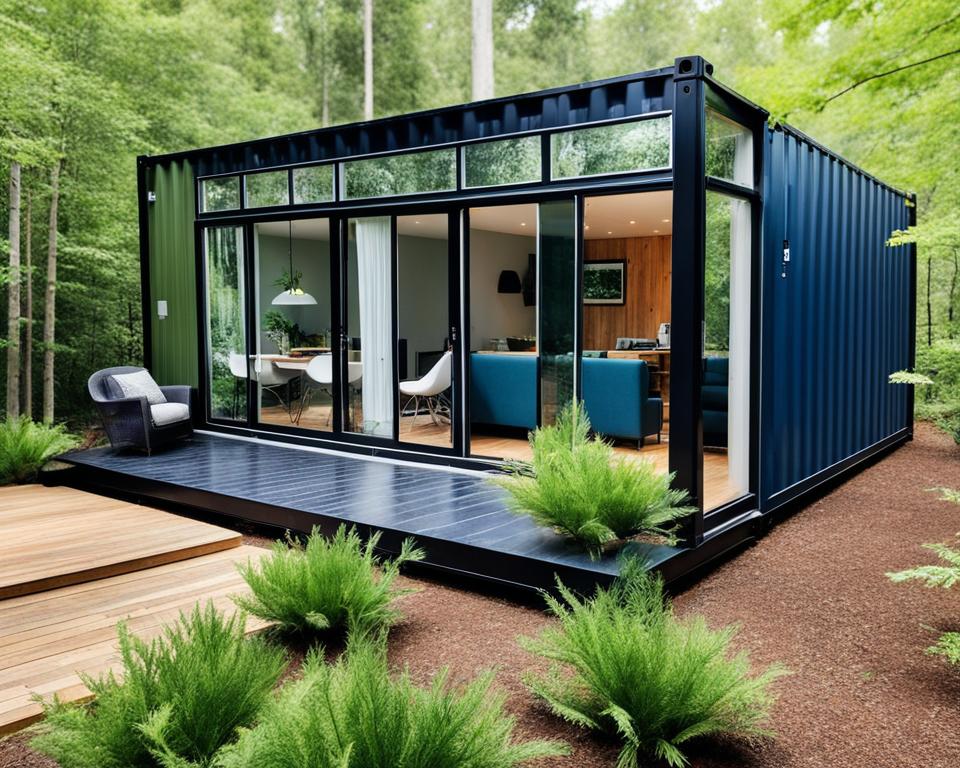Discover the beauty of minimalist living with a stylish tiny house container. In recent years, many have found the charm and practicality of living small. This new way to own a home uses shipping containers, offering simplicity and care for the planet. These tiny homes change how we see space, efficiency, and community, promising a better life for those wanting to live greener and save money.
Key Takeaways
- Tiny homes significantly reduce utility bills due to their smaller size.
- Owning a tiny home often leads to quicker financial freedom as it’s more cost-effective than traditional housing.
- Compact housing promotes minimalist living, reducing waste and encouraging sustainable habits.
- Shipping container home solutions foster a strong sense of community through shared outdoor spaces and collaborative projects.
- Smart home technology in tiny homes optimizes space and enhances efficiency through automated systems.
Introduction to Tiny House Containers
The idea of tiny house containers is becoming more popular in the downsizing trend. These homes come from shipping containers and are efficient and eco-friendly. People like the tiny home lifestyle because it lets them live big with a small footprint.
The Rise of the Tiny House Movement
The tiny house movement is all about living simpler and smaller. It’s about wanting to be sustainable, free financially, and living with less. With housing prices going up, people are looking at container homes as a smart choice. They’re affordable, lasting a long time, and good for the planet.
The cost of a container home varies from $1,400 to $4,000, depending on the condition and where it’s from. This makes them a great option for those looking to save money. Plus, they’re sustainable, which is a big plus for eco-friendly living.
What is a Tiny House Container?
A tiny house container is a home made from a shipping container. These containers are 20 or 40 feet long, 8 feet wide, and 8 feet tall. They’re strong, made from recyclable steel, and can stand up to bad weather. This makes them a great choice for those who want a safe and cozy home.
Building a home from a container also means less waste. This makes it a green choice for those who care about the environment. It’s why many are choosing container homes for their eco-friendly benefits.
Benefits of Tiny House Containers
Tiny house containers are a great choice for sustainable living. They are popular for their eco-friendly design and cost savings. These homes are not just cheap; they are also tough and sustainable.
Sustainability and Eco-Friendliness
These homes are made from recycled shipping containers. This cuts down on waste and saves resources. Using old containers for homes means less need for new materials, which is good for the planet.
They also have a smaller carbon footprint. Their design is efficient, making them a top pick for those who care about the environment.
Cost-Effectiveness
Tiny house containers are affordable, costing between $10,000 and $50,000. They offer a cheaper option compared to traditional houses. Plus, they can save you money on renovations and buying a regular home.
Building one of these homes can be done in just 30 days. This saves on construction costs. You can also add more containers later if you need more space.
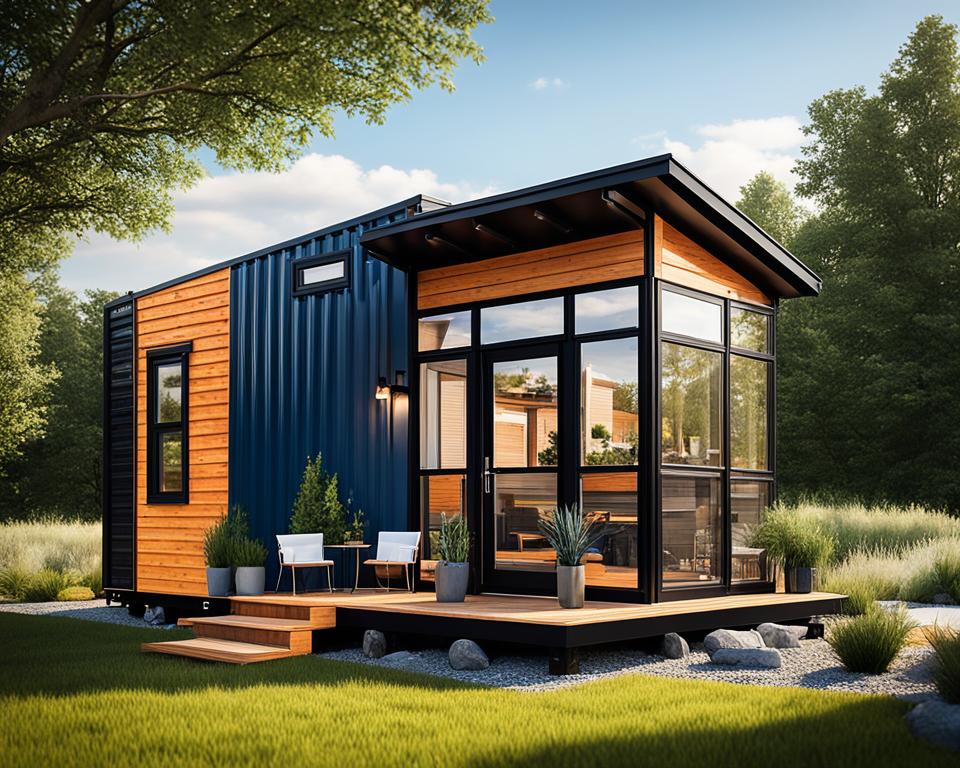
Durability and Weather Resistance
Shipping container homes are very durable and can handle tough weather. They’re made to last, having been designed for harsh sea conditions. This means they can stand up to strong winds, floods, and fires.
Their strong steel structure means they last a long time. This makes them a smart choice for areas with bad weather. They offer a safe and reliable place to live.
Designing a Tiny House Container
Designing a tiny house container means thinking carefully about efficient space use. It also means using the flexibility of shipping containers to your advantage. You can create unique living spaces by playing with different layouts and designs.
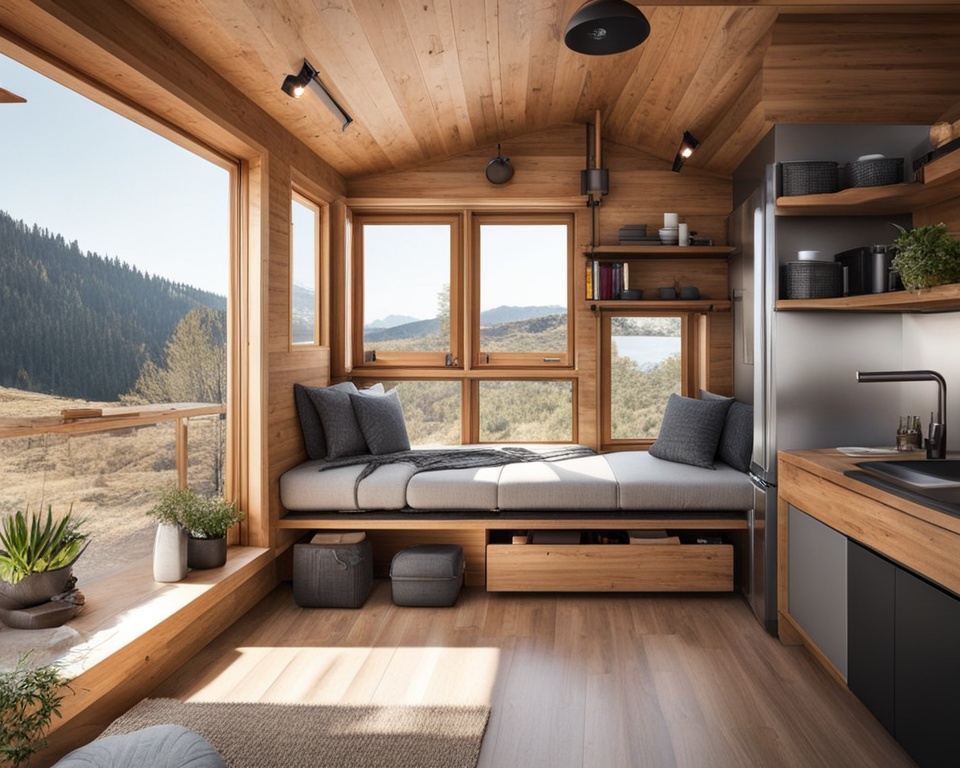
Space Optimization Tips
To make the most of your tiny house container’s space, try these tips:
- Vertical Storage: Use shelves, lofts, and vertical spaces to keep the floor clear.
- Multi-Functional Furniture: Choose furniture that can change, like fold-out tables and beds with storage.
- Natural Light: Big windows and skylights help make the space feel bigger.
- Open Shelving: Open shelving instead of big cabinets makes the room feel more open.
Customization and Personalization Options
One of the best things about tiny home design is making it your own. Here are some ideas:
- Interior Design Styles: You can choose from rustic to modern looks.
- Integrated Spaces: Add walkways, courtyards, and balconies to mix indoor and outdoor living.
- Personal Touches: Use unique colors and custom furniture to show off your style in your customized container home.
- Sustainable Choices: Pick eco-friendly materials and energy-saving appliances to be kinder to the planet.
| Customization Option | Benefits |
|---|---|
| Interior Design Styles | Reflect personal taste, create desired ambiance |
| Integrated Spaces | Seamless indoor-outdoor experience, increased living area |
| Personal Touches | Unique and personalized living spaces |
| Sustainable Choices | Eco-friendly, reduces carbon footprint, cost-saving |
Whether you want to use space wisely or add your own style, the secret to a great tiny home is in smart tiny home design. It’s about making the most of every inch and creating a space that feels like home. This way, you get a cozy, useful, and personal living area that fits your needs.
Cost-Efficiency of Tiny House Containers
Tiny house containers are a smart choice for homeowners looking to save money. They use materials from old shipping containers, making them a budget-friendly option. This makes them popular among those wanting to build economically.
Affordable Building Materials
One big plus of tiny house containers is their affordable materials. You can get a 20-foot shipping container for about $3,000. Building your own tiny home can cost between $10,000 to $40,000, much less than traditional homes which can go over $200,000.
DIY kits for container homes are also available. They come with tools and resources to help build, saving you even more money.
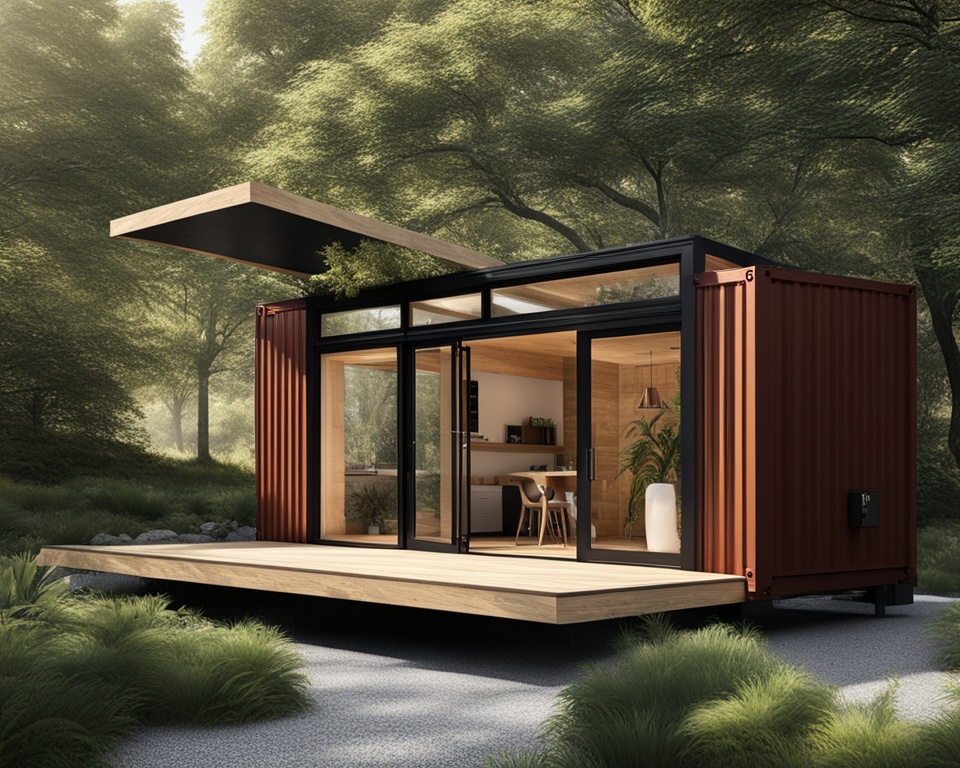
| Expense Type | Tiny House Container | Traditional Home |
|---|---|---|
| Building Materials | Up to $20,000 | Over $200,000 |
| Average Build Time | Few weeks to a few months | 6 to 12 months |
| Foundation Cost | About $5,000 | $15,000 to $30,000 |
| Average Home Cost | $10,000 to $35,000 | $200,000 to $400,000 |
Lower Utility Bills
Tiny house containers also offer big savings on energy costs. Their smaller size means they use less energy for heating, cooling, and appliances. This leads to lower utility bills.
Using modern insulation and energy-efficient appliances can also cut down on energy use. This makes tiny house containers a great choice for saving money.
Overcoming Challenges in Tiny House Living
Living in a tiny house can be rewarding but comes with challenges. You’ll face issues like complex zoning laws, ensuring your home stays warm, and finding smart ways to store things. Being resourceful and informed is key.
Zoning Laws and Regulations
One big challenge is dealing with zoning laws. Tiny houses are often seen as Accessory Dwelling Units (ADUs), which affects their taxes and where you can place them. But, more cities are changing their laws to welcome tiny homes. They see these homes as a way to offer more affordable living and boost the local economy.
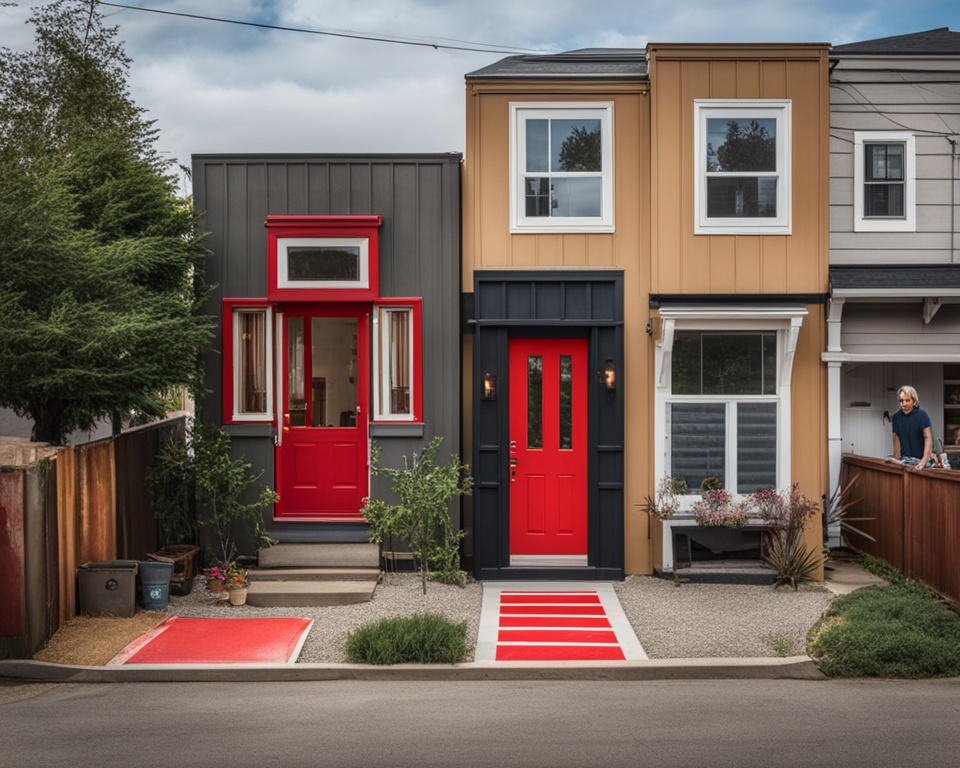
- Top tiny house-friendly states include California, Florida, Colorado, Oregon, and Texas.
- Various methods to overcome zoning challenges include seeking exceptions, changing rules, and explicitly defining tiny houses in local codes.
Insulation and Ventilation Solutions
Keeping your tiny house warm and well-ventilated is key. Because of the small size, good insulation cuts down on energy use. And, proper ventilation stops moisture from building up, keeping your home healthy. Solar power is also becoming more common, offering a green way to power your tiny house.
Storage Innovation
Getting the most out of your tiny house means finding smart storage solutions. Using furniture that saves space and pieces that do more than one thing can really help. For example, built-in shelves, under-bed storage, and furniture that changes into something else are great choices. Working with architects who know about tiny houses can help design a home that fits the rules and has clever storage.
Here’s a comparison of typical living space data:
| Living Space | Average Square Feet |
|---|---|
| New Single-Family Home | 2,435 sq ft |
| Tiny House | 80-400 sq ft |
Tiny House Container as a Modern Living Solution
Tiny house containers are a great example of modern living. They are perfect for people who care about the planet and want to save money. These homes are made from old shipping containers and are both stylish and efficient with space.
They are also very affordable. Building a traditional home can be very expensive. But, tiny house containers are much cheaper. For instance, Tony built his first home for just $13,000, which is a lot less than a regular tiny house.
These homes can be customized to fit your needs. You can stack or arrange them in different ways to create unique spaces. This lets you make your home just how you want it. Companies like Alternative Living Spaces have done many projects, from offices to gyms.
They are also very sustainable. A modular home produces much less CO2 than a traditional house. Using old containers helps reduce waste and supports recycling. These homes are strong and don’t need much upkeep, unlike houses made of wood.
These homes can be moved easily, which is great for people who move around a lot. This makes them a flexible choice for modern living. They offer a smart way to live in the city that is both affordable and good for the planet.
In summary, tiny house containers are a smart choice for today’s housing needs. They turn industrial materials into beautiful homes that are both functional and eco-friendly. For those wanting a sustainable and affordable lifestyle, these homes are a great option.
Eco-Friendly Living in Tiny House Containers
Tiny house containers are leading the way in sustainable living. They use green building materials and aim for low energy use. This makes them a great choice for eco-conscious people and families. The Tiny House Container Village at Yukon Trails Camping Resort shows how cozy and green these homes can be.
The Importance of Recycled Materials
Old shipping containers are now turned into homes. This cuts down on waste and uses fewer new resources. It’s a big step towards sustainable living. Companies like Containerwerk in Germany add to this by using untreated wood on the outside, making the homes even greener.
Energy-Efficient Appliances
Places like Petite Retreats use energy-saving appliances in their container homes. These appliances help keep energy use low while still offering modern comforts. They also use less water, which is good for the planet and your wallet.
Sustainable Living Practices
Tiny house containers and villages are part of a bigger move towards living sustainably. They use space well, have full kitchens, and offer modern comforts like Wi-Fi. Conservation groups praise these homes for their eco-friendly ways. Living in a tiny house encourages a simple life, valuing what’s important most.
Space Optimization Techniques
Living in a tiny house means making the most of every inch. Using vertical storage, furniture that changes function, and smart home tech helps. These methods make the space both useful and tidy.
Vertical Storage Ideas
To make the most of small spaces, think vertically. High shelves or lofts add storage without taking up floor space. Wall-mounted shelves and pegboards save space and keep things within reach.
Cable management tools like cable raceways and desk grommets also help. They keep things tidy and look good. Learn more about these tips here.
Convertible Furniture Solutions
Having furniture that serves more than one purpose is key in tiny houses. Foldable chairs and tables that mount on walls save space. Sliding pantry shelves and under-bed storage keep things organized and out of sight.
Check out these furniture solutions to transform your space.
Incorporating Smart Home Technology
Smart home tech is vital for making the most of space. Built-in appliances and hidden storage add both style and function. Technology can also simplify daily tasks, using every inch wisely.
For more ideas on smart home tech, click here.
Financing and Discounts
Many dream of living in a tiny house, but figuring out how to finance it can be tough. Luckily, there are loans made just for tiny house containers. These loans offer flexible and affordable ways to get your dream home.
Specialized Loans for Tiny Homes
Getting a loan for a tiny house container is easier with the many options out there:
- Conventional loans from Cardinal Financial start at 3% down and need a credit score of 620 for homes on a foundation.
- Secured loans use assets like your home’s equity or a paid-off car as collateral.
- Unsecured loans depend on your credit score and offer flexibility.
- LightStream loans for tiny homes have rates based on AutoPay and range from $5,000 to $100,000.
For those who want to build their own tiny home, Construction Loans offer interest-only payments during the build. This makes them a great choice for many.
| Loan Type | Details |
|---|---|
| Conventional Loans | Down payments as low as 3%, requires a credit score above 620. |
| Secured Loans | Borrowing against assets like equity in a residence or a paid-off car. |
| Unsecured Loans | Based on qualifying credit criteria by the bank. |
| Construction Loans | Interest-only payments during construction. |
Potential Tax Benefits
Switching to a tiny house container can lead to big tax deductions for small homes. Homeowners might get deductions for mortgage interest, property taxes, and energy-efficient upgrades. These deductions can lower the cost of owning a tiny home a lot.
Current Shipping Discounts
Many tiny house makers and sellers offer great shipping deals. For instance, Snake River Tiny Homes gives shipping discounts, making the cost of a container home even lower. With a 5-star rating from all their customers, their staff’s help and knowledge are top-notch. Checking out these deals can be a big win for buyers.
Choosing a tiny house container means looking at tiny home financing options, discounts, and tax incentives. These can make moving to a smaller home easier and cheaper.
Conclusion
Living in tiny house containers is more than a trend; it’s a lifestyle that matches the current trend of living small and caring for the planet. This modern way of living offers many benefits, like saving money and being kind to the environment. It’s perfect for those wanting to simplify their lives.
The popularity of tiny house containers comes from both practical and deep reasons. In the UK, there are about 25,000 off-grid homes and over 1,000 shipping container homes. This shows that this new way of living is becoming more popular. Using shipping containers as homes is a smart way to live with less space and help the environment.
The tiny house container movement is changing the future of homes. It offers big savings on building and upkeep, and it’s more energy-efficient. Plus, these homes can move easily, giving you more freedom to choose where you live. This makes it easier to enjoy nature and live sustainably. As more people want to live in a way that’s good for the planet, tiny house containers are becoming a popular choice for a simpler, greener life.
Source Links
- Tiny Home Compact Living: Space and Style – United Tiny Homes
- Frequently Asked Questions – Tiny House Container
- The Bunkhouse
- Shipping container tiny house – Yinhong Mobile House/home
- Comparing tiny houses, container homes and ADUs
- How One Family Reconnected With a Compound of Tiny Homes
- Exploring Shipping Container Tiny Homes: Advantages & Ideas
- The Pros of Using Shipping Containers for Tiny Homes | A American
- Shipping Container Home vs Tiny House — Häuslein Tiny House Co
- Building a Shipping Container Tiny House: The Ultimate Guide to Eco-Friendly Home Building – United Tiny Homes
- Shipping Container Design: From Tiny Cottage Dwellings To Chic Modern Mansions<br/> — firefly+finch
- Shipping Container Tiny Homes
- Why Are Container Homes in Las Vegas Becoming Popular?
- 5 Benefits Of Shipping Container Homes | FreightCenter
- The Pros & Cons of Shipping Container Homes – Insureberry Insurance Agency
- Living Small. How The Tiny House Movement Found Me.
- Tiny Houses: Introduction, Zoning Obstacles and Solutions
- The Growth of Tiny Homes and the Future of Alternative Housing [transcript]
- Alternative Living Spaces: Shipping Container Dream Homes | Boxhub
- Living Large in a Cozy Box: The Rise of Shipping Container Tiny Homes
- Tiny House vs Shipping Container – Key Differences – Luxe Dreamer
- Tiny House Container Village
- Why Are Container Homes in Las Vegas Becoming Popular?
- Tiny House Container Village: Eco-Friendly Living Redefined
- Designing Tiny Homes Tips and Tricks for Maximising Space and Functionality
- 18 Tiny House Storage Ideas & Organization Hacks | Extra Space Storage
- Maximizing Small Spaces in Tiny Homes: Top Space-Saving Tips – United Tiny Homes
- How to Finance a Tiny House | Cardinal Financial
- Tiny Houses | LightStream
- Discounts
- Container Homes vs Tiny Homes: What’s the Difference? | Live Off Grid
- 4 Reasons to “Live Small” | Containered
- Shipping Container Homes: Pros and Cons

